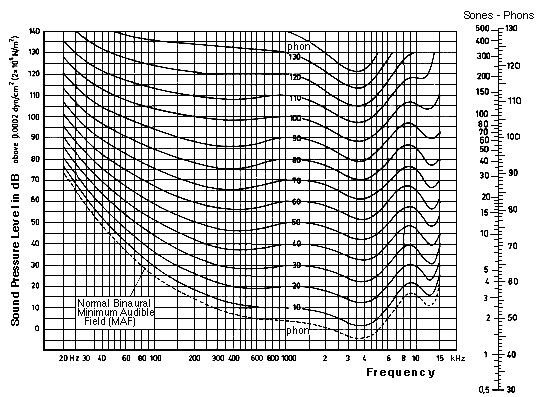A unit used to describe the LOUDNESS LEVEL of a given sound or noise. The system is based on EQUAL LOUDNESS CONTOURS, where 0 phons at 1,000 Hz is set at 0 decibels, the THRESHOLD OF HEARING at that frequency (see graph). The hearing threshold of 0 phons then lies along the lowest equal loudness contour. If the intensity level at 1,000 Hz is raised to 20 dB, the second curve is followed.
It will be noted, therefore, that the relationship between the decibel and phon scale at 1,000 Hz is exact, but because of the way the ear discriminates against or in favour of sounds of varying frequencies, the phon curve varies considerably. For instance, a very low 30 Hz RUMBLE at 110 decibels is perceived as being only 90 phons (see graph); for its effect, however, see INFRASONIC.
Compare: SOUND LEVEL, VOLUME.
It is important to realize that the phon is used only to describe sounds that are equally loud. It cannot be used to measure relationships between sounds of differing loudness. For instance, 40 phons is not twice as loud as 20 phons. In fact, an increase of 10 phons is sufficient to produce the impression that a SINE TONE is twice as loud.
For the purpose of measuring sounds of different loudness, the SONE scale of subjective LOUDNESS was invented. One sone is arbitrarily taken to be 40 phons at any frequency, i.e. at any point along the 40 phon curve on the graph. Two sones are twice as loud, e.g. 40 + 10 phons = 50 phons. Four sones are twice as loud again, e.g. 50 + 10 phons = 60 phons. The relationship between phons and sones is shown in the chart, and is expressed by the equation:
which is analogous to the relation between PNdB and the NOY. See: PERCEIVED NOISE LEVEL.

Equal loudness contours for pure tones and normal threshold of hearing for persons aged 18-25 years, using free-field hearing (from ISO recommendation R226).
home